Topological Phase and Strong Correlation in Rare-Earth Hexaborides XB6 (X = La, Ce, Pr, Nd, Pm, Sm, Eu)
Abstract
1. Introduction
2. Computational Details
3. Results and Discussion
3.1. Topologically Trivial Normal Metal LaB6, CeB6, and PrB6
3.2. Topologically Nontrivial Kondo Insulator SmB6, PmB6, NdB6 and EuB6
4. Conclusions
Author Contributions
Funding
Acknowledgments
Conflicts of Interest
References
- Chang, T.-R.; Das, T.; Chen, P.-J.; Neupane, M.; Xu, S.-Y.; Hasan, M.Z.; Lin, H.; Jeng, H.-T.; Bansil, A. Two distinct topological phases in the mixed-valence compound YbB6 and its differences from SmB6. Phys. Rev. B 2015, 91, 155151. [Google Scholar] [CrossRef]
- Weng, H.; Dai, X.; Fang, Z. Topological semimetals predicted from first-principles calculations. J. Phys. Condens. Matter 2016, 28, 303001. [Google Scholar] [CrossRef] [PubMed]
- Kane, C.L.; Mele, E.J. Z2 topological order and the quantum spin hall effect. Phys. Rev. Lett. 2005, 95, 146802. [Google Scholar] [CrossRef] [PubMed]
- Hasan, M.Z.; Kane, C.L. Colloquim: Topological insulators. Rev. Mod. Phys. 2010, 82, 3045. [Google Scholar] [CrossRef]
- Moore, J.E. The birth of topological insulators. Nature 2010, 464, 194–198. [Google Scholar] [CrossRef]
- Qi, X.-L.; Zhang, S.-C. Topological insulators and superconductors. Rev. Mod. Phys. 2011, 83, 1057–1110. [Google Scholar] [CrossRef]
- Fu, L.; Kane, C.L. Topological insulators with inversion symmetry. Phys. Rev. B 2007, 76, 045302. [Google Scholar] [CrossRef]
- Schell, G.; Winter, H.; Rietschel, H.; Gompf, F. Electronic structure and superconductivity in metal hexaborides. Phys. Rev. B 1982, 25, 1589–1599. [Google Scholar] [CrossRef]
- Demishev, S.V.; Semeno, A.; Bogach, A.; Paderno, Y.; Shitsevalova, N.; Sluchanko, N. Antiferro-quadrupole resonance in CeB6. Phys. B Condens. Matter 2006, 378–380, 602–603. [Google Scholar] [CrossRef][Green Version]
- Barman, C.K.; Singh, P.; Johnson, D.D.; Alam, A. Revealing the nature of antiferroquadrupolar ordering in cerium hexaboride: CeB6. Phys. Rev. Lett. 2019, 122, 076401. [Google Scholar] [CrossRef]
- Morin, P.; Kunii, S.; Kasuya, T. Quadrupolar properties and magnetic phase diagrams in PrB6 hexaboride compound. J. Magn. Magn. Mater. 1991, 96, 145–154. [Google Scholar] [CrossRef]
- Matthias, B.T.; Geballe, T.H.; Andres, K.; Corenzwit, E.; Hull, G.W.; Maita, J.P. Superconductivity and antiferromagnetism in boron-rich lattices. Science 1968, 159, 530. [Google Scholar] [CrossRef] [PubMed]
- Wolgast, S.; Kurdak, Ç.; Sun, K.; Allen, J.W.; Kim, D.-J.; Fisk, Z. Low-temperature surface conduction in the Kondo insulator SmB6. Phys. Rev. B 2013, 88, 180405. [Google Scholar] [CrossRef]
- Zhang, X.; Butch, N.; Syers, P.; Ziemak, S.; Greene, R.L.; Paglione, J. Hybridization, inter-ion correlation, and surface states in the kondo insulator SmB6. Phys. Rev. X 2013, 3, 011011. [Google Scholar] [CrossRef]
- Booth, C.H.; Sarrao, J.L.; Hundley, M.F.; Cornelius, A.L.; Kwei, G.H.; Bianchi, A.; Fisk, Z.; Lawrence, J.M. Local and average crystal structure and displacements of La11B6 and EuB6 as a function of temperature. Phys. Rev. B 2001, 63, 224302. [Google Scholar] [CrossRef]
- Pickard, C.J.; Winkler, B.; Chen, R.K.; Payne, M.C.; Lee, M.H.; Lin, J.S.; White, J.A.; Milman, V.; Vanderbilt, D. Structural properties of lanthanide and actinide compounds within the plane wave pseudopotential approach. Phys. Rev. Lett. 2000, 85, 5122. [Google Scholar] [CrossRef] [PubMed]
- Degiorgi, L.; Felder, E.; Ott, H.R.; Sarrao, J.L.; Fisk, Z. Low-temperature anomalies and ferromagnetism of EuB6. Phys. Rev. Lett. 1997, 79, 5134–5137. [Google Scholar] [CrossRef]
- Süllow, S.; Prasad, I.; Aronson, M.C.; Bogdanovich, S.; Sarrao, J.L.; Fisk, Z. Metallization and magnetic order inEuB6. Phys. Rev. B 2000, 62, 11626–11632. [Google Scholar] [CrossRef]
- Kunii, S.; Takeuchi, K.; Oguro, I.; Sugiyama, K.; Ohya, A.; Yamada, M.; Koyoshi, Y.; Date, M.; Kasuya, T. Electronic and magnetic properties of GdB6. J. Magn. Magn. Mater. 1985, 52, 275–278. [Google Scholar] [CrossRef]
- Weng, H.; Zhao, J.; Wang, Z.; Fang, Z.; Dai, X. Topological crystalline kondo insulator in mixed valence ytterbium borides. Phys. Rev. Lett. 2014, 112, 016403. [Google Scholar] [CrossRef]
- Xia, M.; Jiang, J.; Ye, Z.R.; Wang, Y.H.; Zhang, Y.; Chen, S.D.; Niu, X.H.; Xu, D.F.; Chen, F.; Chen, X.H.; et al. Angle-resolved photoemission spectroscopy study on the surface states of the correlated topological insulator YbB6. Sci. Rep. 2014, 4, srep05999. [Google Scholar] [CrossRef] [PubMed]
- Walker, H.C.; McEwen, K.A.; McMorrow, D.F.; Bleckmann, M.; Park, J.-G.; Lee, S.; Iga, F.; Mannix, D. X-ray resonant scattering study of the structural and magnetic transitions in PrB6. Phys. Rev. B 2009, 79, 054402. [Google Scholar] [CrossRef]
- Allen, A. Phase Diagrams 6-V: Materials Science and Technology; Elsevier: Amsterdam, The Netherlands, 2012. [Google Scholar]
- Kresse, G.; Hafner, J. Ab initio molecular-dynamics simulation of the liquid-metal-amorphous-semiconductor transition in germanium. Phys. Rev. B 1994, 49, 14251. [Google Scholar] [CrossRef] [PubMed]
- Kresse, G.; Furthmüller, J. Efficient iterative schemes for ab initio total-energy calculations using a plane-wave basis set. Phys. Rev. B 1996, 54, 11169–11186. [Google Scholar] [CrossRef]
- Blöchl, P.E. Projector augmented-wave method. Phys. Rev. B 1994, 50, 17953. [Google Scholar] [CrossRef]
- Perdew, J.P.; Burke, K.; Ernzerhof, M. Generalized gradient approximation made simple. Phys. Rev. Lett. 1996, 77, 3865–3868. [Google Scholar] [CrossRef] [PubMed]
- MacKinnon, I.D.; Alarco, J.A.; Talbot, P.C. Metal hexaborides with Sc, Ti or Mn. Model. Numer. Simul. Mater. Sci. 2013, 3, 158–169. [Google Scholar] [CrossRef][Green Version]
- Blomberg, M.; Merisalo, M.; Korsukova, M.; Gurin, V. Single-crystal X-ray diffraction study of NdB6, EuB6 and YbB6. J. Alloys Compd. 1995, 217, 123–127. [Google Scholar] [CrossRef]
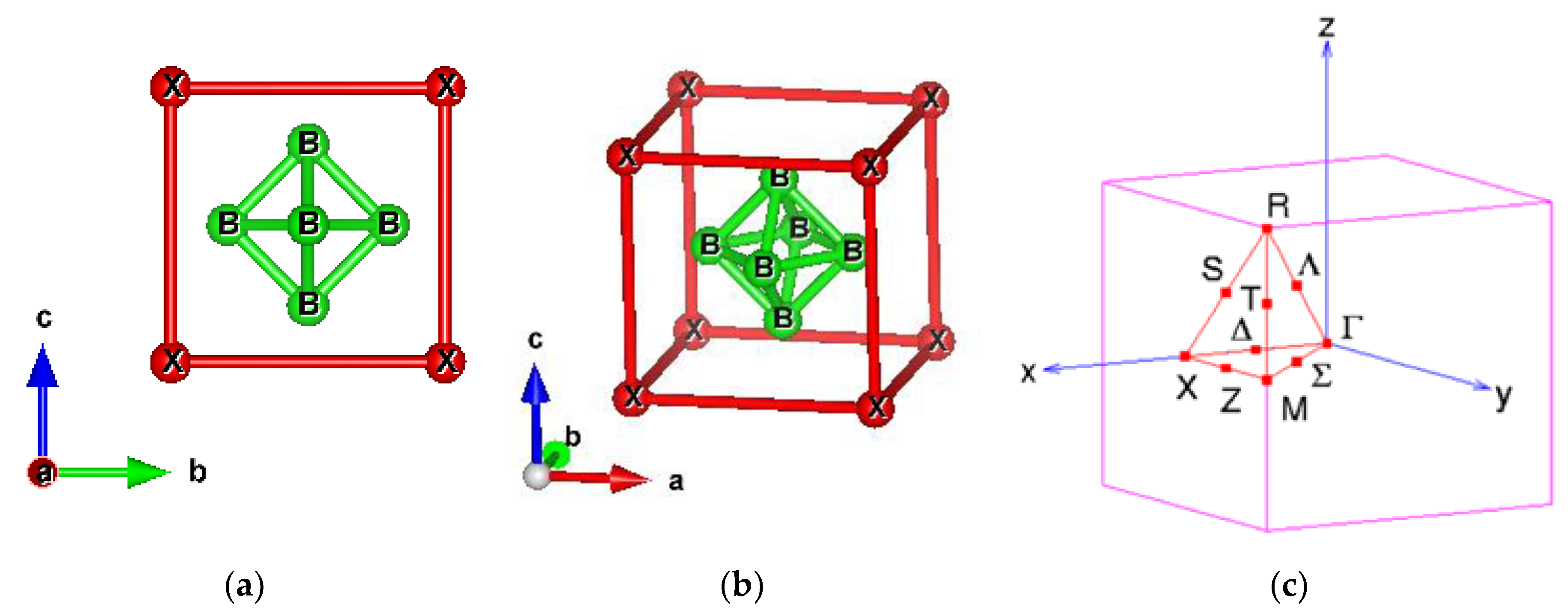
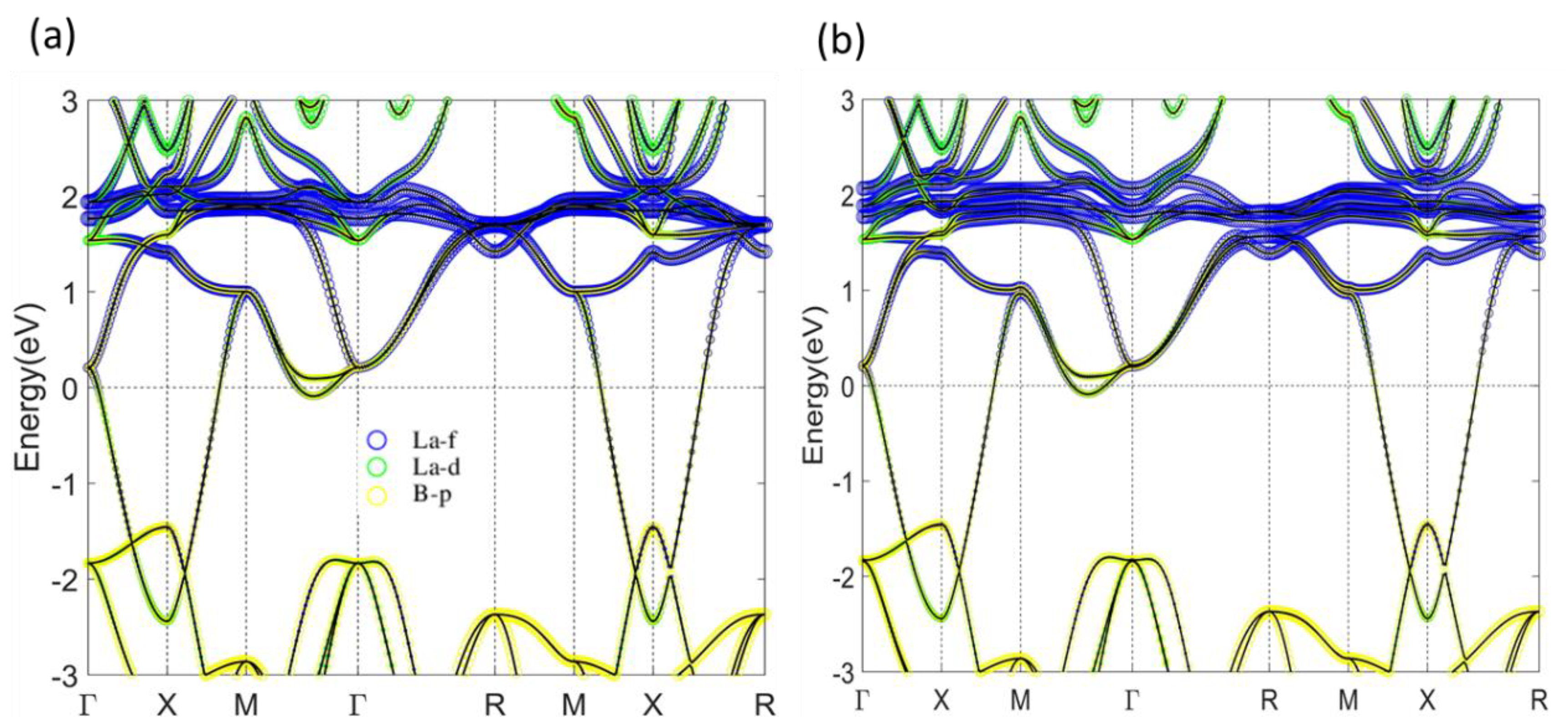
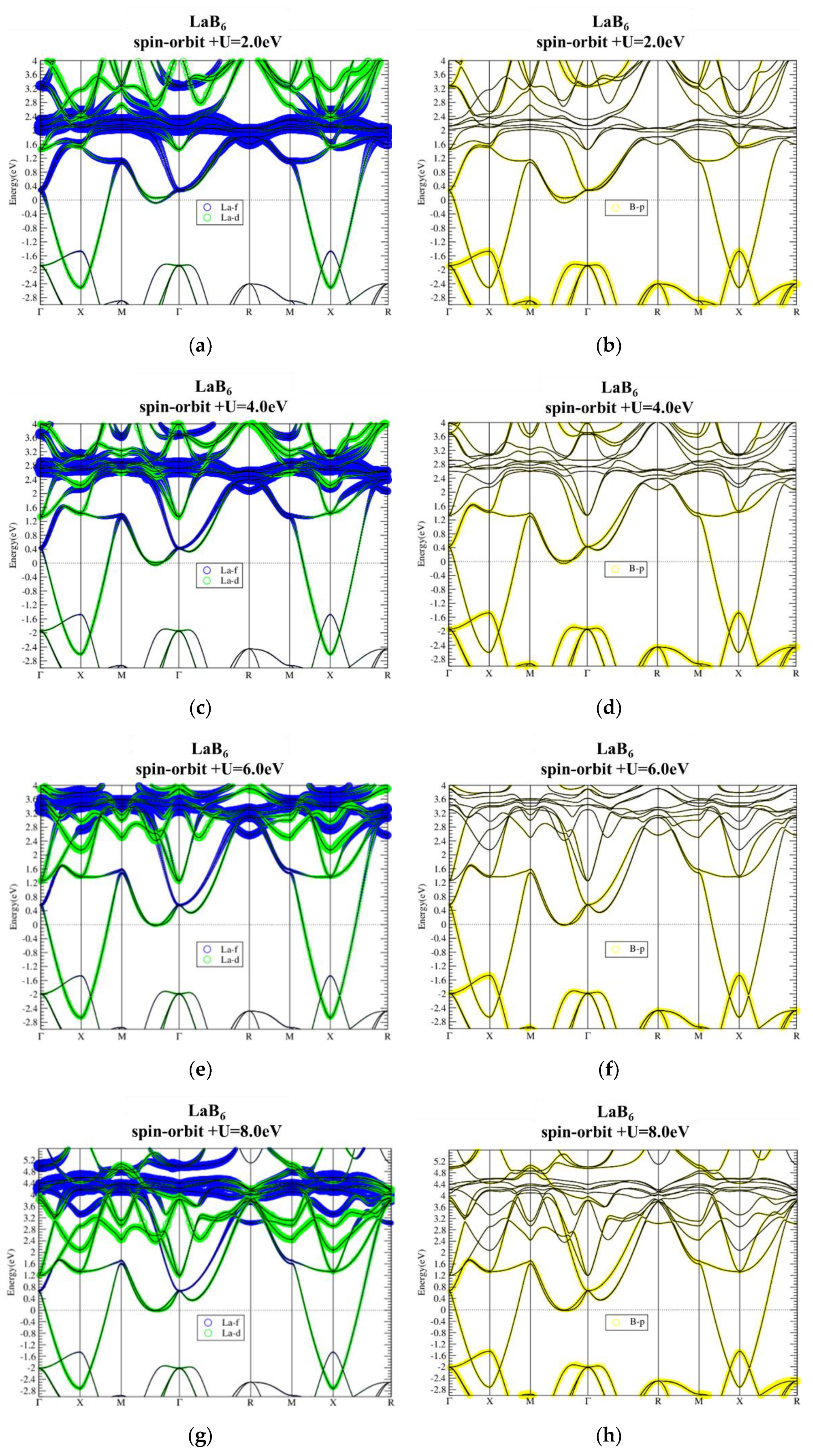
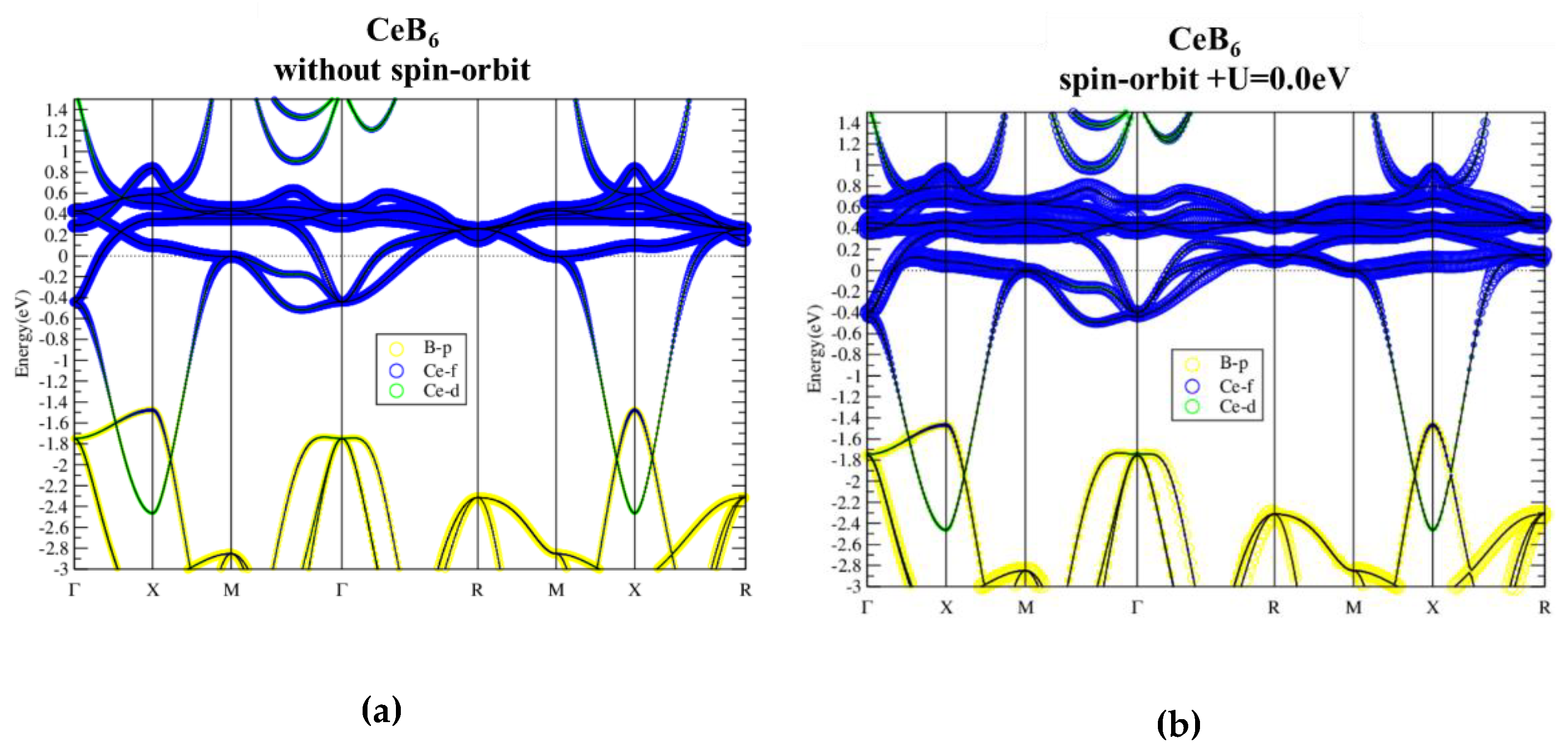
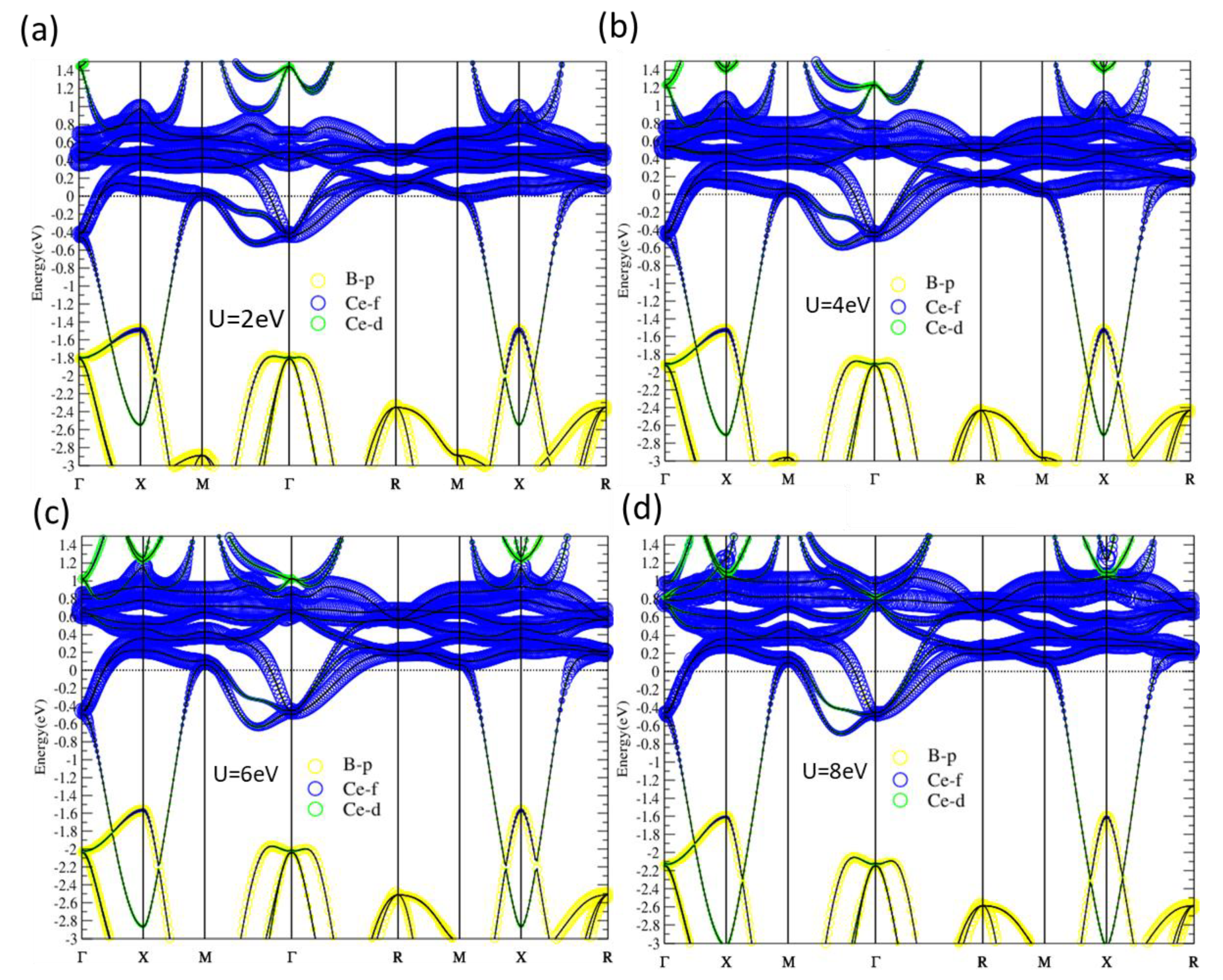
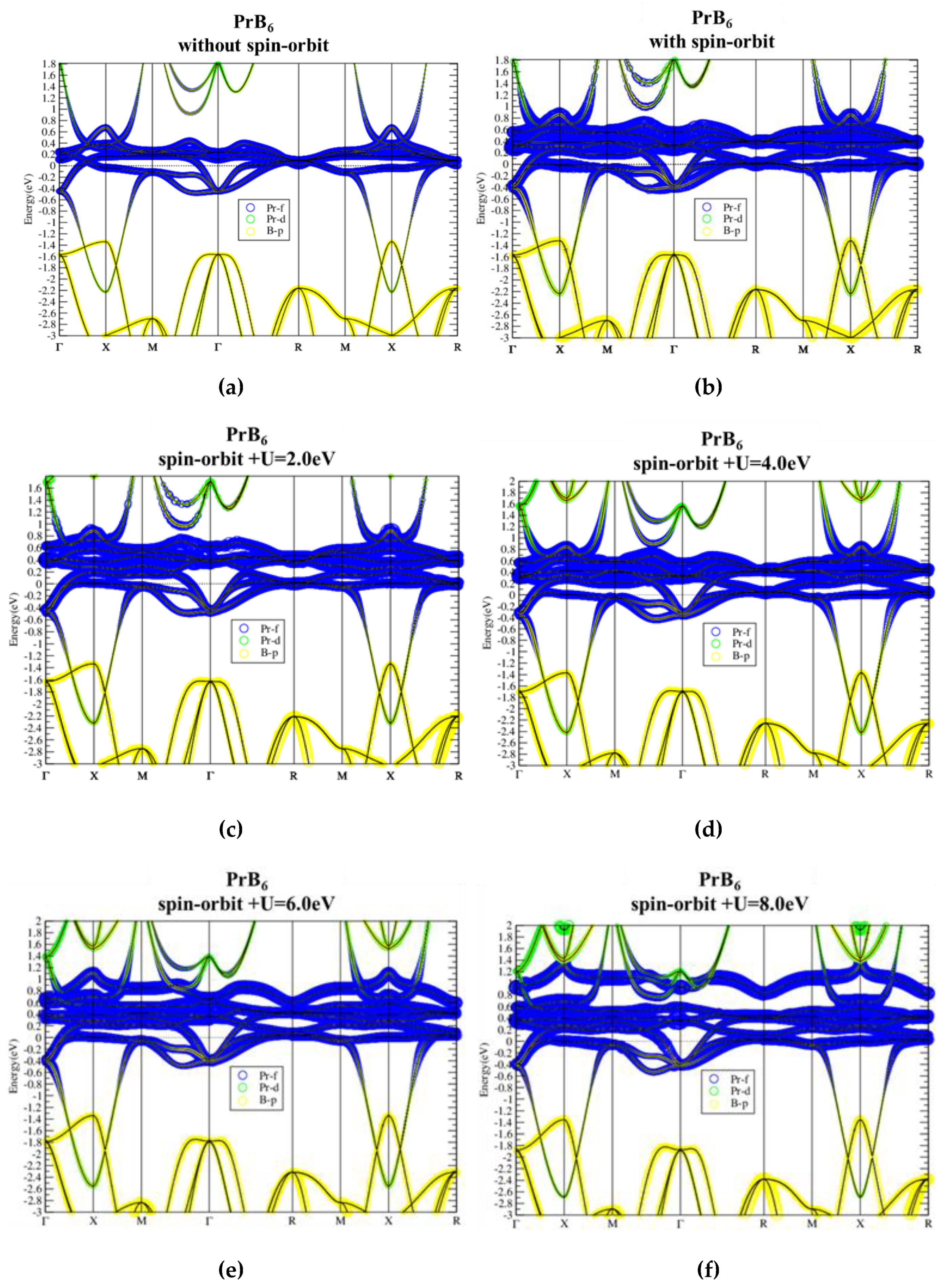

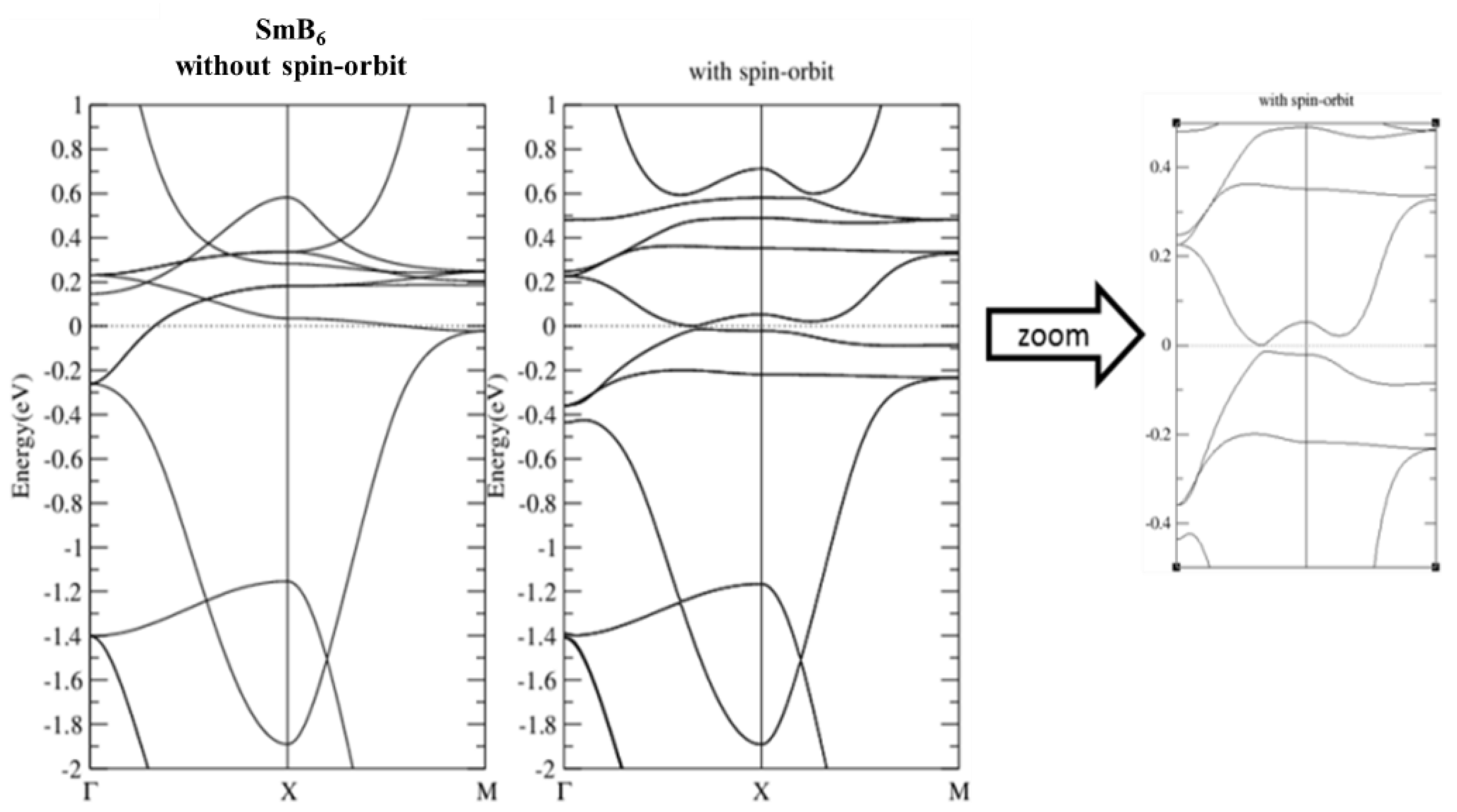
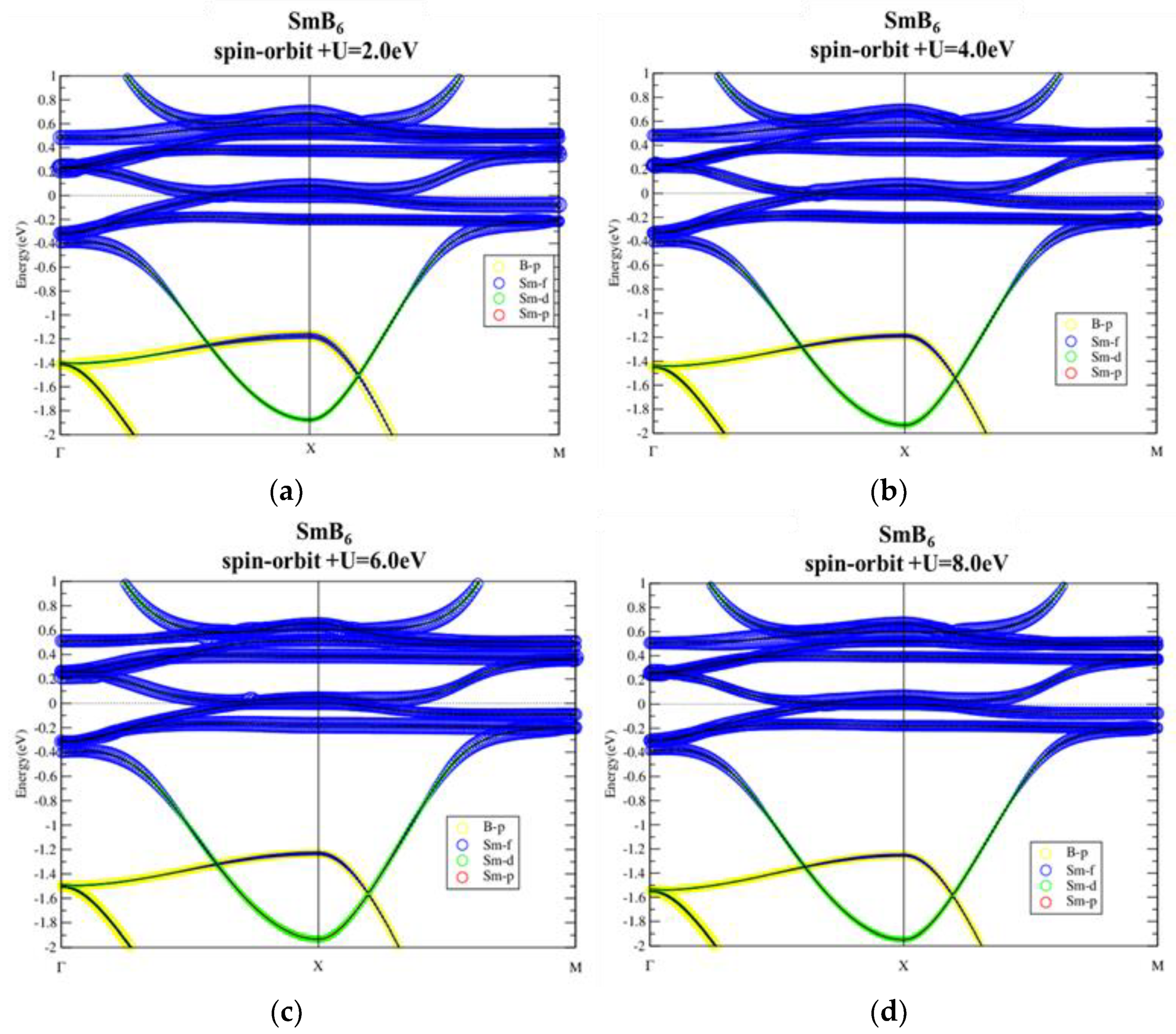
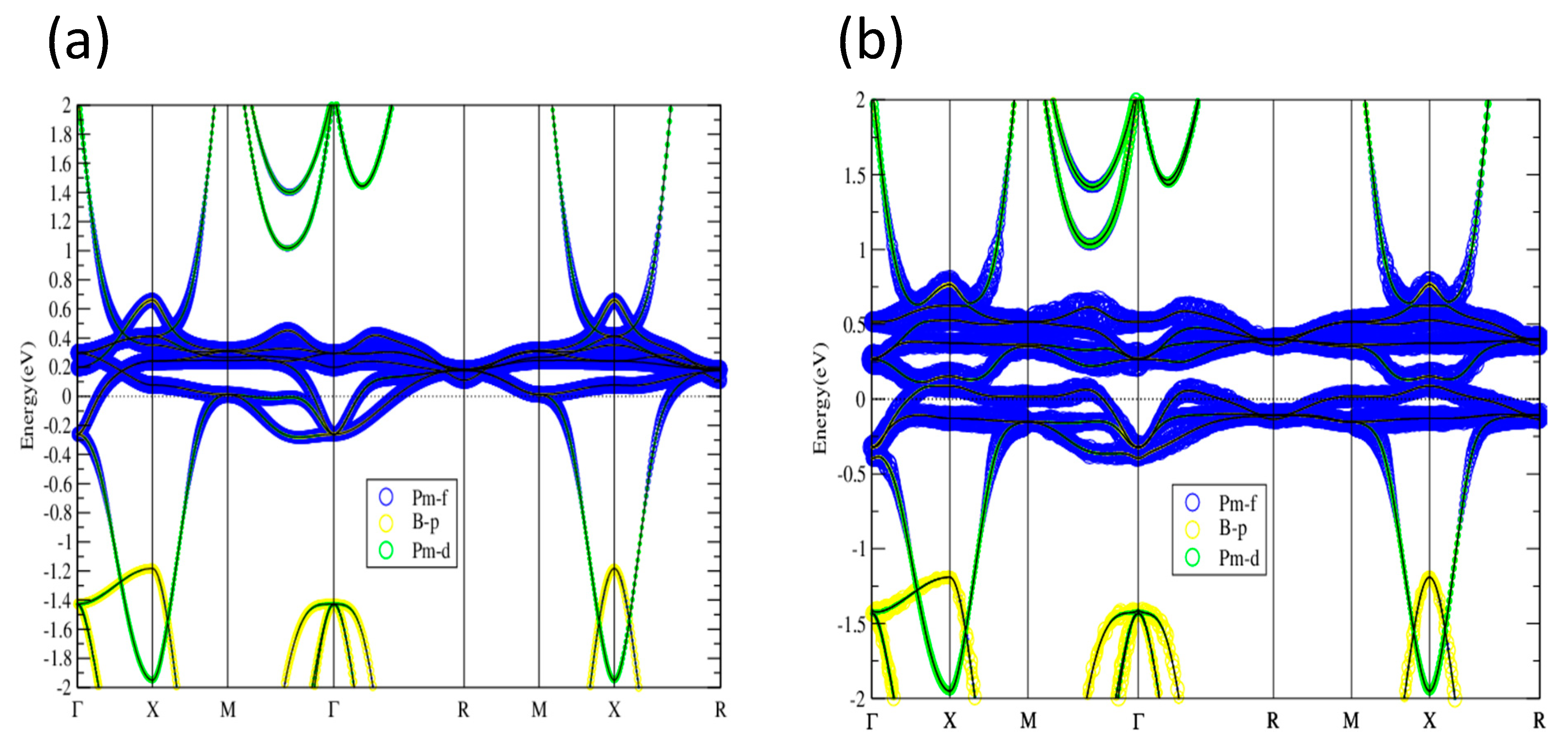
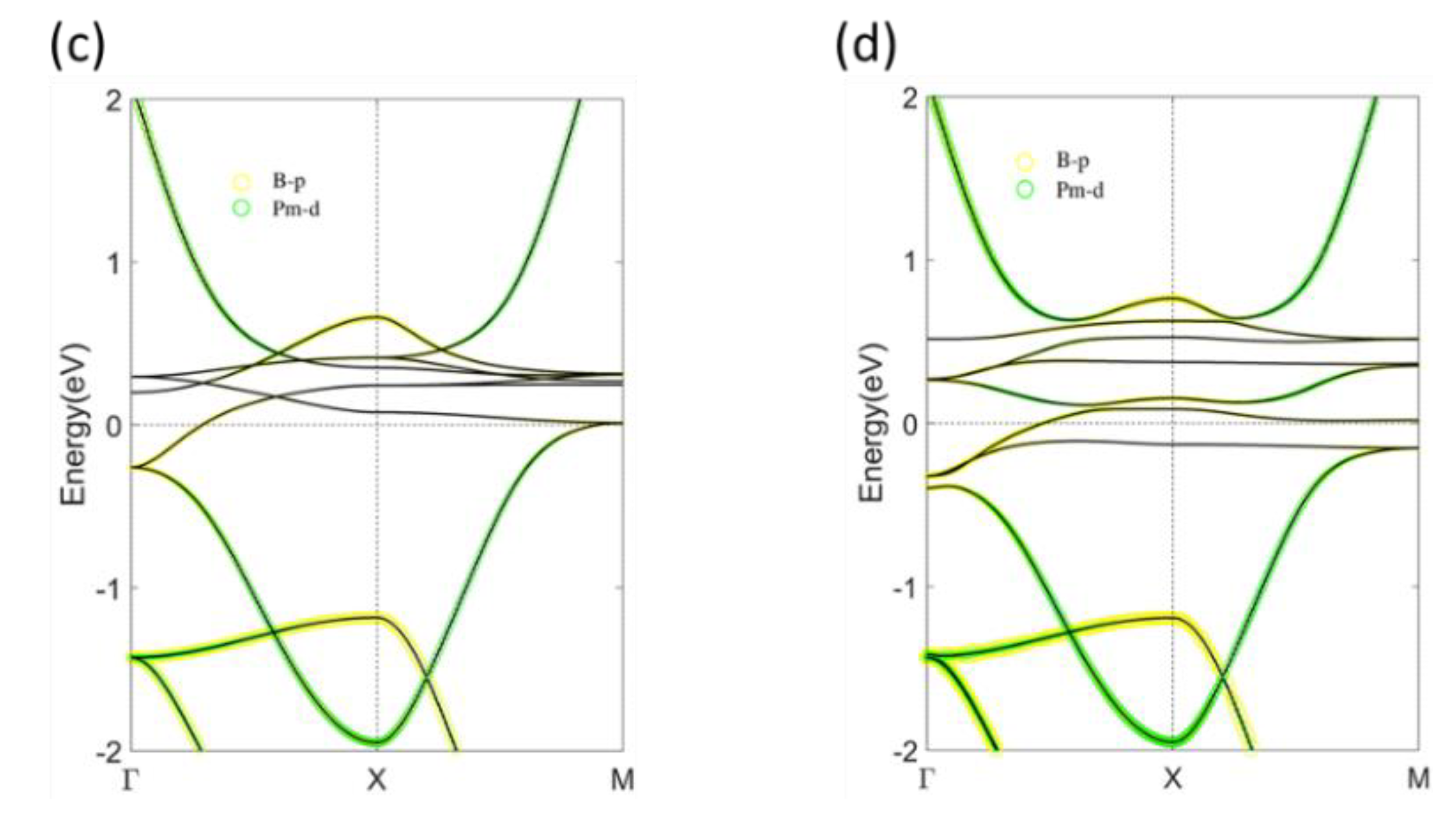



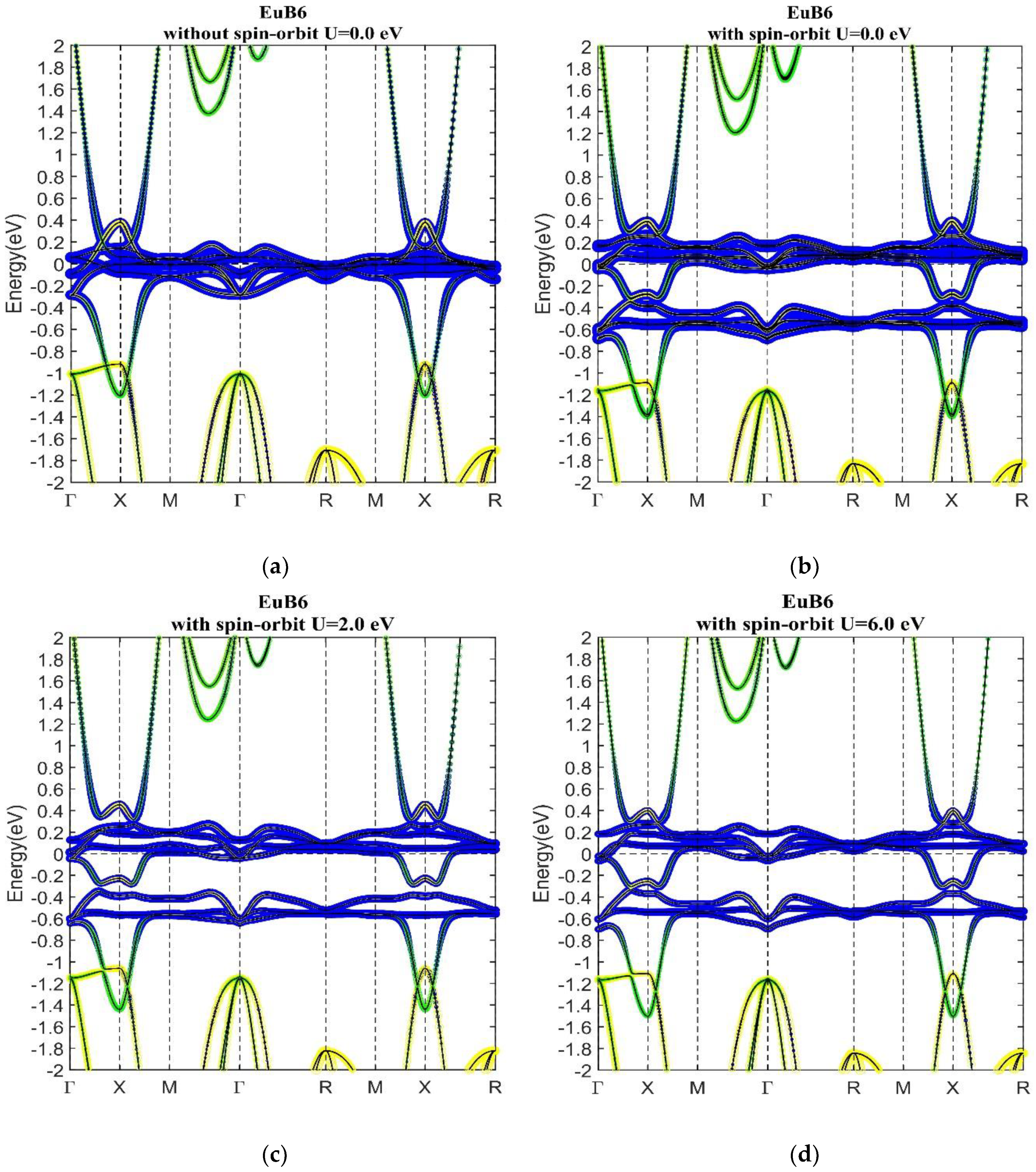
| aexp (Å) | athe(Å) | Error of a | B(z)exp | B(z)the | B–B Bond Lengthexp(Å) | B–B Bond Lengththe(Å) | |
|---|---|---|---|---|---|---|---|
| LaB6 [15] | 4.1527 | 4.1553 | 0.06% | 0.1993 | 0.1997 | 1.7660 | 1.7647 |
| CeB6 [16] | 4.14 | 4.1130 | −0.65% | 0.1992 | 0.1984 | 1.7611 | 1.7543 |
| PrB6 [22] | 4.13 | 4.1024 | −0.67% | 0.2 | 0.1984 | 1.7522 | 1.7498 |
| NdB6 [16] | 4.127 | 4.1007 | −0.64% | 0.1989 | 0.1987 | 1.7574 | 1.7473 |
| PmB6 [23] | 4.128 | 4.1131 | −0.36% | 0.2 | 0.1990 | 1.7514 | 1.7508 |
| SmB6 [28] | 4.1346 | 4.1087 | −0.63% | 0.2018 | 0.1993 | 1.7436 | 1.7474 |
| EuB6 [29] | 4.1849 | 4.1325 | −1.25% | 0.2027 | 0.1999 | 1.7595 | 1.7539 |
| YbB6 [29] | 4.1444 | 4.1325 | −0.29% | 0.207 | 0.2007 | 1.7173 | 1.7492 |
© 2020 by the authors. Licensee MDPI, Basel, Switzerland. This article is an open access article distributed under the terms and conditions of the Creative Commons Attribution (CC BY) license (http://creativecommons.org/licenses/by/4.0/).
Share and Cite
Hung, S.-H.; Jeng, H.-T. Topological Phase and Strong Correlation in Rare-Earth Hexaborides XB6 (X = La, Ce, Pr, Nd, Pm, Sm, Eu). Materials 2020, 13, 4381. https://doi.org/10.3390/ma13194381
Hung S-H, Jeng H-T. Topological Phase and Strong Correlation in Rare-Earth Hexaborides XB6 (X = La, Ce, Pr, Nd, Pm, Sm, Eu). Materials. 2020; 13(19):4381. https://doi.org/10.3390/ma13194381
Chicago/Turabian StyleHung, Sheng-Hsiung, and Horng-Tay Jeng. 2020. "Topological Phase and Strong Correlation in Rare-Earth Hexaborides XB6 (X = La, Ce, Pr, Nd, Pm, Sm, Eu)" Materials 13, no. 19: 4381. https://doi.org/10.3390/ma13194381
APA StyleHung, S.-H., & Jeng, H.-T. (2020). Topological Phase and Strong Correlation in Rare-Earth Hexaborides XB6 (X = La, Ce, Pr, Nd, Pm, Sm, Eu). Materials, 13(19), 4381. https://doi.org/10.3390/ma13194381





